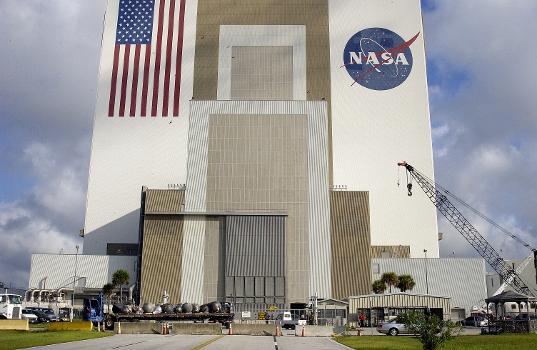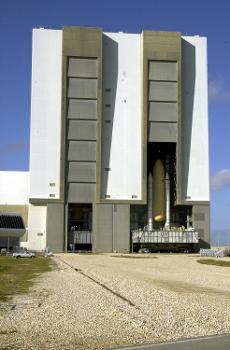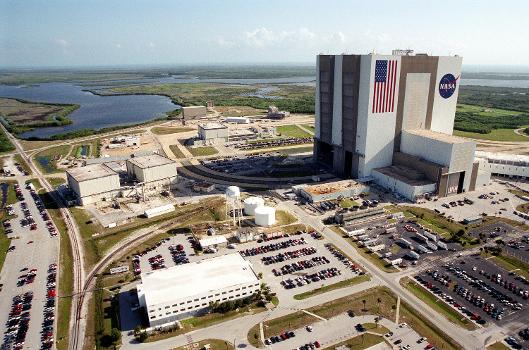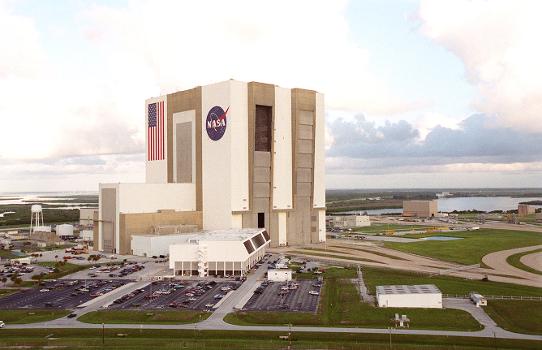General Information
| Completion: | 1965 |
|---|---|
| Status: | in use |
Project Type
| Function / usage: |
Spacecraft hangar / assembly building |
|---|---|
| Material: |
Steel structure |
Location
| Location: |
Cape Canaveral, Brevard County, Florida, USA |
|---|---|
| Part of: | |
| Coordinates: | 28° 35' 9.84" N 80° 39' 2.82" W |
Technical Information
Dimensions
| width | 158 m | |
| height | 160 m | |
| length | 218 m | |
| number of floors (above ground) | 40 | |
| building volume | 3 664 883 m³ |
Quantities
| structural steel | 89 421 t | |
| concrete volume | 49 696 m³ |
Materials
| building structure |
steel
|
|---|
Excerpt from Wikipedia
The Vehicle (originally Vertical) Assembly Building, or VAB, is the large building at NASA's Kennedy Space Center (KSC), designed to assemble the large pre-manufactured space vehicle components, such as the massive Saturn V and the Space Shuttle; and stack them vertically onto the Mobile Launch Platform and crawler transporter. The future Space Launch System (SLS) will also be assembled there.
At 3,664,883 cubic meters (129,428,000 cubic feet) it is one of the largest buildings in the world by volume. The building is at Launch Complex 39 at KSC, halfway between Jacksonville and Miami, and due east of Orlando on Merritt Island on the Atlantic coast of Florida.
The VAB is the largest single-story building in the world, was the tallest building (160.3 meters, 526 ft) in Florida until 1974, and is still the tallest building in the United States outside an urban area.
History
The VAB, which was completed in 1966, was originally built to allow for the vertical assembly of the Saturn V rocket for the Apollo program and referred to as the Vertical Assembly Building. In anticipation of post-Saturn projects such as the Space Shuttle program, it was renamed the Vehicle Assembly Building in 1965, and was used for the shuttle's external fuel tanks and flight hardware, and to mate the Space Shuttle orbiters to their solid rocket boosters and external fuel tanks. Once assembled, the complete Space Shuttle was moved on the Mobile Launcher Platform and Crawler-Transporter to LC-39 Pad A or B.
Construction
In 1963, NASA contracted the Morrison-Knudsen company to design and build the VAB. Construction began with driving the first steel foundation piles on Aug. 2, 1963. It was part of NASA's massive effort to send astronauts to the Moon for the Apollo Program. Altogether, 4,225 pilings were driven down 164 feet to bedrock with a foundation consisting of 30,000 cubic yards of concrete. Construction of the VAB required 98,590 tons of steel. The building was completed in 1966. The VAB is 526 feet (160.3 m) tall, 716 feet (218.2 m) long and 518 feet (157.9 m) wide. It covers 8 acres (3 ha), and encloses 129,428,000 cubic feet (3,665,000 m³) of space.
Located on Florida's Atlantic coast, the building was constructed to withstand hurricanes and tropical storms. Despite this, it has received damage from several hurricanes (see below).
Capabilities
There are four entries to the bays located inside the building, which are the four largest doors in the world. Each door is 456 feet (139.0 m) high, has 7 vertical panels and 4 horizontal panels, and takes 45 minutes to completely open or close. The north entry that leads to the transfer aisle was widened by 40 feet (12.2 m) to allow entry of the shuttle orbiter. A central slot at the north entry allowed for passage of the orbiter's vertical stabilizer.
To lift the components of the Space Transportation System, the VAB housed five overhead bridge cranes, including two capable of lifting 325 tons, and 136 other lifting devices.
The building has at least 40 MW of air conditioning equipment, including 125 ventilators on the roof supported by four large air handlers (four cylindrical structures west of the building) to keep moisture under control. Air in the building can be completely replaced every hour. The interior volume of the building is so vast that it has its own weather, including "rain clouds form[ing] below the ceiling on very humid days", which the moisture reduction systems are designed to minimize.
Exterior
The American flag painted on the building was the largest in the world when added in 1976 as part of United States Bicentennial celebrations, along with the star logo of the anniversary, later replaced by the NASA insignia in 1998. It is 209 feet (63.7 m) high, and 110 feet (33.5 m) wide. Each of the stars on the flag is 6 feet (1.83 m) across, the blue field is the size of a regulation basketball court, and each of the stripes is 9 feet (2.74 m) wide. Work began in early 2007 to restore the exterior paint on the immense facility. Special attention was paid to the enormous American flag and NASA "meatball" insignia. The work repaired visible damage from years of storms and weathering. The flag and logo had been previously repainted in 1998 for NASA's 40th anniversary.
The most extensive exterior damage occurred during the storm season of 2004, when Hurricane Frances blew off 850 14 × 6 foot aluminum panels from the building, resulting in about 40,000 square feet (3,700 m²) of new openings in the sides. Twenty five additional panels were blown off the east side by the winds from Hurricane Jeanne just three weeks later. Earlier in the season, Hurricane Charley caused significant but less serious damage, estimated to cost $700,000. Damage caused by these hurricanes was still visible in 2007. Some of these panels are "punch-outs", designed to detach from the VAB when a large pressure differential is created on the outside vs. the inside. This allows for equalization, and helps protect the structural integrity of the building during rapid changes in pressure such as in tropical cyclones.
The building has been used as a backdrop in several Hollywood movies including Marooned, SpaceCamp, Apollo 13, Contact, and others.
Future
The Space Shuttle was retired in 2011 after which NASA temporarily (as early as 2012) offered public tours of the VAB. These tours were temporarily discontinued in February 2014 to allow for renovations to take place.
The NASA FY2013 budget included US$143.7 million for Construction of Facilities (CoF) requirements in support of Exploration programs including Space Launch System (SLS) and Multi-Purpose Crew Vehicle (MPCV). NASA began modifying Launch Complex 39 at KSC to support the new SLS in 2014, beginning with major repairs, code upgrades and safety improvements to the Launch Control Center, Vehicle Assembly Building (VAB) and the VAB Utility Annex. This initial work will be required to support any launch vehicle operated from Launch Complex 39 and will allow NASA to begin modernizing the facilities, while vehicle-specific requirements are being developed.
The VAB could be used to some extent for assembly and processing of any future vehicles utilizing Launch Complex 39, in addition to renovations for SLS capabilities. On June 16, 2015, NASA released an announcement for proposals (AFP) seeking interest in using the VAB High Bay 2 and other complex facilities for commercial use in "assembling, integration, and testing of launch vehicles." This move is in line with the intent to migrate KSC towards acting as a spaceport accessible to both government and commercial ventures. On April 21, 2016, NASA announced the selection of Orbital ATK to begin negotiations for High Bay 2. The "potential agreement" includes an existing mobile launcher platform.
Text imported from Wikipedia article "Vehicle Assembly Building" and modified on 22 July 2019 under the CC-BY-SA 3.0 license.
Participants
Relevant Web Sites
Relevant Publications
- (1965): Hangar pour fusées lunaires. In: Acier = Stahl = Steel, v. 30 (May 1965), pp. 225.
- About this
data sheet - Structure-ID
20003280 - Published on:
19/05/2002 - Last updated on:
05/04/2020












